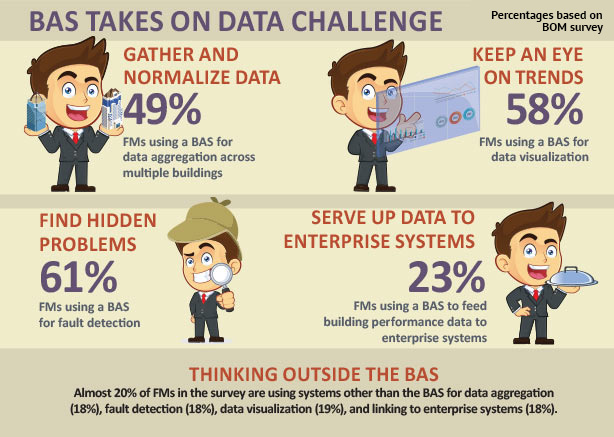Where Does the Building Automation System Fit In An Internet of Things World?
Part 1 of a 3-part article exploring how the BAS is the backbone of any Building Internet of Things initiative.
In an era where microchips are embedded in everything that operates electronically, Internet of Things (IoT) technology is showing up everywhere, from cars that drive themselves to smart thermostats and health-monitoring bracelets. In commercial and institutional facilities, the Building IoT already has made significant inroads in lighting, HVAC, video surveillance, and numerous other building systems and subsystems.
As the Building IoT expands, facility managers may wonder what role the building automation system (BAS) will play in this brave new world of sensors and Big Data. After all, the Building IoT offers a new range of options for advanced functions like aggregating data and detecting hidden faults in HVAC operations.
Don’t count the BAS out, say industry sources. Most BAS manufacturers do not see the BAS disappearing or even being undermined by IoT technology. Instead, they see the BAS as being enhanced with expanded capabilities and functionality.
BAS: Where the IoT Began
Most facility managers think of the building control system when the subject of the IoT comes up, according to a recent Building Operating Management survey, with 85 percent of respondents associating IoT with controls. Experts view the legacy BAS as the precursor to today’s IoT. “Over the past two to three decades, the move to direct digital controls led to sensors and actuators communicating through BAS to keep building occupants comfortable,” observes Rich Blomseth, director of product management at Echelon. The use of open protocols and standards like LonMark and BACnet made it possible for devices from different manufacturers to interface, expanding the range of machine-to-machine communication.

Communication and interoperability capabilities have given the BAS a key role in facilities. But today, the rapid growth of the IoT is presenting facility managers with a wide range of new technology choices.
One reason for the phenomenal growth of the IoT is the rapid decrease in component costs, according to Peter Middleton, research director at Gartner. Gartner estimates IoT’s installed base will grow to 26 billion units by 2020.
“By 2020, component costs will have come down to the point that connectivity will become a standard feature, even for processors costing less than $1,” says Middleton. “This opens up the possibility of connecting just about anything, from the very simple to the very complex, to offer remote control, monitoring, and sensing.”
In Gartner’s report, “Forecast: The Internet of Things, Worldwide, 2013,” the IoT industry includes the devices themselves as well as embedded software, communications services, and information services associated with the devices. In the building industry, IoT is showing up in some widely used current smart-building technologies, including light-emitting diode (LED) lighting and intelligent HVAC systems.
Changing Role
The growth of the Building IoT means more data — and that’s good news for the BAS.
“The crux of IoT is connecting sensor data from a variety of devices and making sense of it,” says Sudhi Sinha, vice president of product development for Johnson Controls. Sinha notes that BAS has been doing just that by collecting building systems data and using analytics to optimize operations “for a very long time.”
In fact, Darcy Otis, director of analytics and fault detection for the building technologies division at Siemens, says “the BAS is an integral part of the IoT environment.” The IoT is simply giving the BAS role “more information and better tools” to perform its core functions, he says.
But that doesn’t mean there won’t be changes in the BAS as more facility managers tap the cloud’s ability to amass massive amounts of data and quickly make that information useful. “The functionality of BAS will change as IoT is implemented,” says Sohrab Modi, Echelon vice president of engineering. “Building management systems will need to be more flexible and scalable.”
Modi predicts some key operations will remain within the BAS domain, while others may be best accomplished in the cloud.
Otis believes the cloud’s capabilities can improve building management systems. “Using a tablet, the building operator may use a cloud app to prioritize, based on predictive information, when things need to be changed or serviced,” he says. “At the same time, he or she may tap into a BAS app, also accessible on the tablet, to get a real-time view of the same system in operation.”
While he believes they can work well together, Otis points out that the BAS and the IoT come from two different technological bases. “BAS, its apps, and support are the domain of the engineering profession,” Otis explains. “They have the expertise in engineered systems.” By contrast, he says, “IoT comes from the information technology profession.” By nature, IT is more concerned with data and statistics, while engineering focuses on how building systems actually operate.
Sinha from Johnson Controls considers the cloud “an efficient storage container and processing platform for Big Data.” He also knows, however, that data may not always be complete. “Your analytics have to account for any data gaps.”
Sinha uses a high temperature reading on one sensor to illustrate his point. It may indicate a fire. But it also may mean the sensor’s temperature gauge is malfunctioning for some other reason. “This is where contextualizing data with domain bias and correlating data with other types of information becomes vital,” he points out.
Data management is an increasing challenge for building automation companies. Tom Zaban, executive vice president of sales and marketing, Reliable Controls, says the priorities are access to data — “how to get it, how to sort it, how to filter it, how to deal with large data sets in an efficient and meaningful way” — and also delivery of data in ways that make it useful for decision-making.
___________________
IoT Series
This is the third article in our ongoing Building Internet of Things series.
Read the first article about data here.
Read the second article about startups here.
Read the fourth article about cybersecurity here.
Read the fifth article about LEDs here.
Read the sixth article about cross-industry collaboration here.
Read the seventh article about mobile here.
Read the eighth article about getting started with IoT here.
Related Topics:












